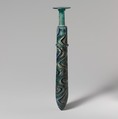Glass gold-band mosaic alabastron (perfume bottle)
Neck and rim disk: translucent turquoise green. Body: colorless, translucent turquoise green, translucent cobalt blue, opaque white, and gold leaf.
Rim disk and neck: flat, broad, horizontal rim, with rounded edge; cylindrical neck with uneven surface and vertical ribbing; projecting solid flange with downward taper that fits tightly into mouth of body and flat horizontal bottom edge; body: plain vertical rim, slightly beveled and tapering upward; tall, slender body, expanding downwards, then curving in to pointed bottom.
On exterior of body, gold-band mosaic pattern formed from parallel wavy lengths of four canes set vertically: the first in turquoise green; the second in gold leaf sandwiched between two layers of colorless glass; the third in cobalt blue with a thin white stripe; and the fourth again in gold leaf sandwiched between two layers of colorless glass; each cane repeated three times over the body.
Neck and rim disk: intact; a few pinprick bubbles, dulling, patches of whitish iridescent weathering, and encrustation with neck; body: broken and repaired with one small chip in rim and some small holes in cracks; slight dulling and faint whitish weathering.
This cast and carved vessel belongs to a distinctive group of Late Hellenistic containers that comprised a body made of lengths of colored glass and a detachable neck and rim of translucent monochrome glass. The colored bands on the body include ones made of gold leaf sandwiched between layers of colorless glass.
Due to rights restrictions, this image cannot be enlarged, viewed at full screen, or downloaded.

